ABSTRACT
The effects of olive mill effluent on evaporation assessed from the surface of two kinds of soil sandy loam and loam textures with two different temperatures. In the other hand five treatments for each texture were prepared in three replicates, including wastewater treatment stained with olives in a value and two percent, compost mixture treatments, mulch amount equal to 50 tons/h, control and water. Eleven treatments were used. Treatments only to a depth of 5.0 cm of soil were applied. 0.0 to 5.0 cm depth of soil particles passed through the eight millimeters sieve and the remaining depth to bottom pot (13 cm) were full by a particle passed through 2.0 mm sieve. By measuring weight loss pots completely "wet every day of the evaporating three months for each period temperature were assessed. Soil temperature in depths of 2.0 and 10.0 cm twice each day, once at 8 a.m. (temperature achieved during the night) and the other at 19 p.m. (temperature gained during the day) were recorded. Stored soil moisture in different potential (zero, 0.05, 0.1, 0.3, 1.5 and 15 bar) in the olive mill effluent for both texture by pressure plates and tempi cells were measured. Statistical analysis of data from completely randomized design (CRD). These results indicate that the rate of the hydrophobic material used in both textures had indirect relation with evaporation from the soil surface.
Key words: Olive mill effluent, mulch, compost mixture, evaporation.
Abbreviation:
OME, olive mill effluent; CE, Cumulative evaporation; CER, Cumulative evaporation reduction
Nowadays using the artificial and natural mulch is one of the operations that maintain soil moisture and decrease evaporation rates. Hydrophobic materials such as (OME) seem useful (Melloli et al., 1998). Evaporation reduction methods using hydrophobic materials modifications and changes based on hydrodynamic upper soil is firm. Below in the water volume in the unsaturated soil hydraulic conductivity and water level rise in capillary tubes decreased and thus decrease the rate of evaporation (Mansell, 1970). In addition, soil moisture cause soil mechanical strength reduces and root growth increase than the available soil water is extracted.
Melloli et al. (1998) also studies the effect of olive mill effluent form with a completely mixed with the soil material in the form of reduced evaporation compared to spraying the soil surface were significantly higher announcement. Cumulative evaporation and wastewater treatment aggregate mixture after forty-six days compared to the control of 27.9% indicated that the reason there was aggregate stability in soil, reducing and changing the angle of unsaturated hydraulic conductivity in a capillary tube was declared.
Studies of soil amendment concept stages of soil evaporation from the descriptive to the quantitative form developed. Usually three main evaporation steps when dry soil is wet can be used (Hillel, 1980). Merely the first stage controls the rate of energy intake and continues until the water level in the soil surface is not limited. Air drying of soil surface area begins second phase evaporation. At this stage evaporation rate gradually decreases and is controlled by the soil profile. In the third stage of evaporation rate is very low and constant. During the third phase of water movement in soil as a vapor is greater and may take several months. First stage ends when the curve of (CE) to separate free water from the soil. Pot a long intermediate phase is observed because the energy levels and aspects of the pot is supplied (Movahedi and Cook, 2000). Daily changes in demand for farm atmosphere for evaporation and vapor transport to the soil surface at night and distillation, the evaporation process of converting first to the second stage and the image may occur. This phase is called the intermediate phase and is very short compared to the pot. Coupled method for measuring and controlling the rate of evaporation from soil and effectiveness of amendments in pot measured by CER graph. Difference between cumulative water loss from each treatments and control called CER. Maximum evaporation reduction (MER) in the CER curve is highest.
The purpose of this study compared evaporation rates, soil temperature, water holding capacity and soil bulk density in the control treatments,1 and 2% hydrophobic waste water, mulch and mixed compost with soil.
Two-pot experiment at intervals from November 2002 until August 2004 to investigate the effect of hydrophobic substances from olive waste on soil temperature, reducing evaporation and increasing cumulative moisture storage was done. First experiment in normal room temperature and uncontrolled conditions (period 2613 h) and second experiment in a growth chamber with controlled temperature (during the time 1111 h) was performed. Experiments in a completely randomized design with five treatments and three replications into plastic pots 20.5 cm diameter and 18 cm in height were performed. First and second experiment treatments consisted of pure water (to determine the free water surface evaporation compared phase evaporation), bare soil (control), compost mix (equivalent to fifty tons per hectare) mulch, (equivalent to fifty tons per hectare) two percent of hydrophobic material and a percentage of hydrophobic material. For this study, two types of light and heavy soil textures of the two points around the city were collected. The first sample (loam soil) of the Jahan - abad village (Inceptisols) and the other from the same city in southern (sandy loam soil) Entisols (fluvent) was collected. Both of samples got from Gorgan city – Golestan province. After transferring the samples to the laboratory some were sieved by 2 and 8 mm mesh.
Control treatment in both textures (sandy loam and loam) with filling pots of 0 to 2 mm aggregates up to 6 cm pot and put the edge of the texture particles 0 to 8 mm to the height of 5 cm until on the edge 1 cm pots were prepared. Mulch treatment for surface preparation for both textures, similar to control treatment in lower pots, soil, 0 to 2 mm and 0 to 8 mm in the top soil was poured on the amount of 405 g of soil with compost rotten wet moisture content 53.04%, which was equivalent to 30 tons of straw on the field. Mixed compost consist compost with the soil pots (both texture) mixed. Prepare for an active percent with 100 g soil, mixing 6.7 ml of (OME) with 11.3 ml distilled water, volume reached 18 ml. Soil moisture contents between 11 to 29% caused uniform coating aggregate with wastewater is sprayed. Low moisture content in effluent infiltration into the pores is less in higher moisture contents of the material inside the pores and cover large accumulations are not uniform. Spraying operation very carefully and slowly and regularly done. Soil particles 0 to 8 mm are impregnated with this substance for several days and then stained with the aggregate exposed to air again left to dry air. Drying soil to create irreversible bonds or ability between the components back slower hydrophobic materials and soil is essential.
Treatment for the preparation of 2% for each 100 g of soil 13.4 ml of olive waste with 4.6 ml of pure distilled water volume was 18 ml and sprayed on the aggregate was 0 to 8 mm. After air-drying treatments, like the previous treatments were applied (Melloli et al., 1998). Evaporation rate and soil temperature were measured twice every day, first at 8 am and second at 19 pm.
Table 1 show analysis of physical and chemical concentration and some salts in two soil textures. Acidity, electrical conductivity (mmho /cm), density (mg/m3) and organic material in (OME) were respectively 5.5, 19.8, 1.3 and 14.9. Saturated moisture percentage in loam and sandy loam, respectively, 40.68 and 52.75 and moisture percentage in compost was 53.04. Duration first stage of evaporation under high evaporation potential in comparison to the low evaporation potential in soil textures was decreased (Table 2). Movahedi and Cook (2000) and Pryhar et al. (1996) also pointed to this and were told that the first stage of dry phase decreases in higher potential evaporation. Bond and Willis (1971) also reported that the duration of dry phase with slow evaporation increased. In this experiment the high evaporation potential cause first stage evaporation time has fallen.
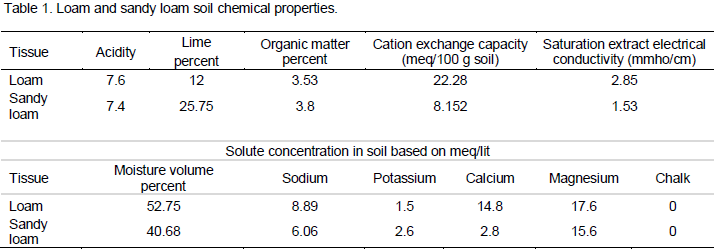

Cumulative evaporation reduction in the different treatments on upper and lower atmosphere potentials in the forms 1 to 4 is seen. Maximum cumulative evaporation reduction (MER) on the top curve is happen (Movahedi Naeini and Cook, 2000). Maximum cumulative evaporation reduction (MER) value and duration that treatments achieve to maximum cumulative evaporation reduction is given in Table 3. Evaporation rate and soil temperature, twice daily, 8 am (during the night) and 7 pm (during the day) was measured (Tables 4 and 5). The correlation between the soil surface evaporation rate (mm/hours) and soil temperature at depths of 2 and 10 cm in all treatments was calculated. The correlation coefficients and significance levels for the morning and afternoon measurements in atmospheric potential evaporation ware calculated. The results are presented in Table 6. There is more correlation between the intensity of evaporation and soil heat in 2 and 10 cm deep.



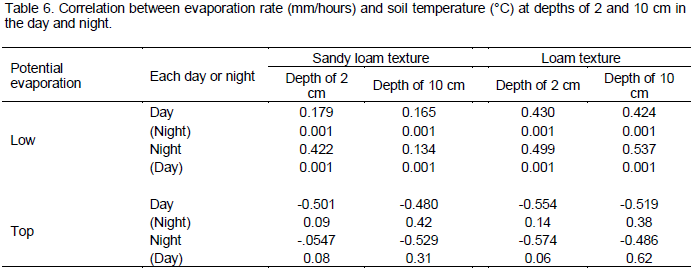
Volumetric soil moisture content in different potential for hydrophobic treatments only one and two percent in both the sandy loam and loam soil in suction potential zero, 0.05, 0.1, 0.3, 1, 5 and 15 bars were measured. The only significant difference in suction between zero and two percent of a hydrophobic treatments in sandy loam soil is found (Table 7) that the exact cause is unknown. Between these treatments and there was no significant difference in loam soil. May cause an increase in total soil pores with zero suction and 2% hydrophobic treatment and soil aggregate stability by this treatment.
Fairbourn and Gardner (1975) in soil were tested to see that the entire hydrophobic treatments Arquad R20 and aggregate stability were increased. This study may also aggregate with a two percent hydrophobic treatment to the end of the experiment lasting the control treatment is outstanding. This increases the total volume of pores in the sandy loam soil (percentage of total pores in the zero suction (Table 7) should be reduced bulk density compared to the control (Table 8) is cost-effective results that do not match. Hydrophobic treatment may increase aggregate stability of two percent in the sandy loam soil and thus prevent their density decreased unsaturated soil hydraulic conductivity is compared with the controls. The hydraulic transport water to the surface can reduce soil evaporation be reduced. The additional effects through increased contact angle with water wall tubes by hairy hydrophobic treatments are applied. Receive test results more clearly with different percentages of hydrophobic treatments in both heavy and light texture is required to repeat. In sandy loam soil in the lower atmosphere potential CER decreased for two percent hydrophobic treatment 18.7 mm, which was occurred after 995 h (Table 3 and Figure 1). But at high temperatures with high evaporation rate of the demand to reduce evaporation 9.49 after 303 h had been occurred (Table 3 and Figure 2). Cumulative evaporation loss for the loam texture in low-temperature 5.8 and 1.0 mm at high temperatures was respectively 1061 and 327 h now occurred. Therefore, increase the evaporation vulnerability and fine texture reduce the amount of the MER in two percent hydrophobic (OME). Therefore, because with increasing air evaporation vulnerability all moisture evaporates into the fluid transfer is not possible, more than the form of moisture vapor is transferred and the hydrophobic material such as fluid flow humidity affect the results over time reduce its impact on evaporation rate decreases. Finer texture soil increased soil unsaturated hydraulic conductivity and thus increase the transfer rate of liquid water below the surface of the pot, regardless of ambient temperature is. Because 5.0 cm above the soil surface layer of between 0.0 to 8.0 mm aggregates formed under this section the 0.0 to 2.0 mm aggregate, thus unsaturated hydraulic conductivity slow in the upper section and water flow in this layer is mostly water vapor. Thus finer soil texture and more abundant moisture in lower layers of security caused more water vapor to transfer through the upper air layer, the atmosphere is large and hydrophobic materials such as found in the upper layers of water move only on the basis of fluid effective, their impact on loam soil The sandy loam soil moisture content than the form of transfer is more fluid in it was decreased. Because moisture in sandy loam soil is less than the lower layer fluid flow of water to steam mode is higher. Because in farm the soil surface heat transfer takes place only, so the use hydrophobic materials and drying temperature on the soil surface may be concentrated at the soil surface and thus the cooling effect of soil depth than flow evaporation velocity fluid is slower than the pot. Therefore, the influence of these materials on evaporation in the field may be completely different pots. Reduce the amount of cumulative evaporation for the hydrophobic (1%) treatment of sandy loam soil in low and high potential evaporation atmosphere respectively 13.3 and 7.2 mm, respectively 969 and 318 h after it happened. According to Table 2, Figures 3 and 4 reduce the amount of cumulative evaporation in loamy soil at high and low potential evaporation was negligible atmosphere. MER rate at low temperature for mulch in the sandy loam 14.9 and 14 mm in the loam was 969 and 1061 h, respectively after the test occurred.

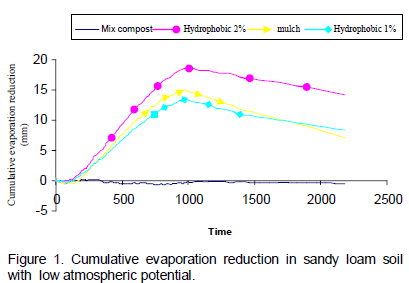

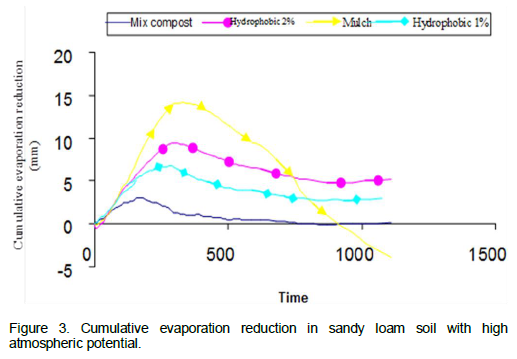
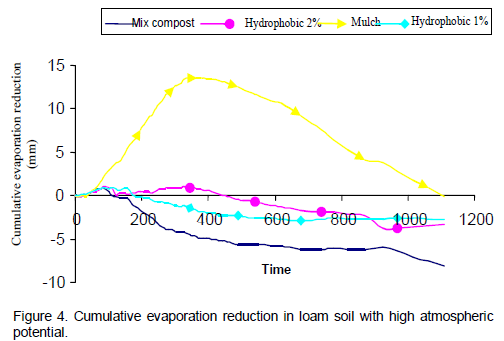
High evaporation potential in the atmosphere, sandy loam to reduce the amount of cumulative evaporation for the mulch treatment 14.1 and loam 13.5 mm was respectively 327 and 366 h in the time it happened. Thus reducing the amount of cumulative evaporation for mulch low atmospheric evaporation potential in sandy loam and loam soils of less than 2.0% of hydrophobic treatments but its value was higher than other treatments. Comparison of hydrophobic material and the mulch evaporated under field conditions should be tested in the same conditions. So can you download all treatments (except mix compost that is in both soil and hydrophobic one percent in loam soils effect on evaporation have not) in low temperature environment compared with the high temperature environment much more moisture in both soil storage and reduced speed evaporation from the soil surface have been occurred. These findings contrast Movahedi and Cook (2000). Their experiments conducted in black pots that unlike much of the energy achieve in high temperature and low temperature around the pot was entered. Therefore, potential evaporation increased with soil drying was not considered a barrier to evaporation. In this regard Movahedi and Cook (2000) expressed that mulch municipal compost residues in high temperature environments than the low temperature decreasing the cumulative evaporation increase in the clay loam soil.
In this study, both the soil for all treatments regardless of treatment with both mixed compost a percentage of hydrophobic soil and loam soil that have had no effect on evaporation in high temperature environment, time to reach the MER in low temperature decreased due to the faster dry and high soil temperatures earlier entry phase is evaporated. The MER value for all soil treatments at higher temperatures than these amounts in low temperature environments and the other was obtained in less time. Movahedi and Cook (2000) and Taban and Movahedi Naeini (2006) also showed that the effect for mulch in high evaporation potential conditions, is shorter.
The results of the treated compost mixture evaporated at low evaporation potential similar results Movahedi and Cook (2000) monitoring expression ends at the low potential evaporation, atmospheric conditions, evaporation of the treated compost mixture similar to the control treatment and more treatment is mulch. Results for MER values (Table 3) shows that increasing hydrophobic consumption evaporation from soil surface is also lower. However, higher intake of hydrophobic substances other comprehensive (in terms of increased risk of erosion) require that the plans recommended in order to determine the maximum allowable consumption of hydrophobic material form field should be done in light soils.
Results of mean soil temperature for different treatments and atmosphere conditions, high evaporation and low for both sandy loam and loam soils at depths of 2.0 and 10.0 cm were studied (Tables 4 and 5). In both test and histological grade in both hydrophobic potential evaporation treatments had no significant effect on soil temperature. The transfer of hydrophobic materials such as mulch evaporation not effective and therefore have no effect on temperature, evaporation latent. These materials form liquid water on the effective hydraulic conductivity. High potential evaporation conditions mean temperature in 10.0 cm depth in both sandy loam and loam to 2.0 cm deep in the night and the day was more than that for treatments; this difference in temperature is significant depths. Thus evaporation during the night and day under the influence of energy absorption cross wall pots and latent heat transfer is performed. Unlike in pots under field conditions due to a temperature inversion and evaporation pressure inversion at night there is no evaporation (Movahedi and Cook, 2000). High potential evaporation in the soil surface drying faster and faster reduction of diffusion temperature, the temperature at the soil surface and thus focuses strongly correlation between evaporation and soil temperature and disappears (Table 6). Because of low soil moisture, that is, the intensity of evaporation drying temperature decreases and vice versa in the depths of the soil surface 2.0 and 10.0 cm increased the lead to evaporation and lack of correlation between the intensity and soil surface temperature is negative. Thus in high evaporation potential for atmospheric, highest energy factor came from below and around the pot. In low evaporation potential for atmospheric correlations greater between evaporation intensity and temperature of soil in 2.0 and 10.0 cm. Therefore, by using the (Table 6) heat transfer and how to supply energy for evaporation in conditions of low evaporation potential for recent experimental pots and farm conditions have the most similarities. In intense evaporation condition, increasing heat transfer around the inside of the pot, similar to how heat transfer is reduced with the farm. Movahedi and Cook (2000) in similar research, placing pots into another pot without painting, (white pots), which were attempted entry into the pots of energy loss can produce around them. But the absence of a significant negative correlation between soil temperature and evaporation rate indicates that this was not enough action for the above purpose and energy also came from around the pot. In the present study stained positive effect of white pots on the wall to prevent entry of energy we have created conditions of low evaporation potential.
The experiments at high temperatures mulch with slow evaporation during the night and day, reduced waste latent heat soil and increase soil temperature at depths of 2.0 and 10 cm evaporation vulnerability layer than controls were, in most cases the difference in potential evaporation over the environment was significant. Temperature had little guidance organic mulch is in contrast to field, pot condition reduced heat transfer mulch below the surface of the soil and this is causing soil cool during the day. Also on the night of the heat transfer from soil air and atmosphere, thus preventing an increase in comparison with control heat transfer is during the night. Although under field conditions with slow evaporation and day latent heat transfer is reduced by mulch, but increased soil temperature in this way very little from soil temperature decreased by entering the soil surface. In short, the overall results suggest the following:
(i) The use of hydrophobic material sprayed pot for hot areas of evaporation control is not suitable. Potential evaporation increases, its effect is reduced.
(ii) Because the soil treatments as determined aggregate sized devices require that special conditions are everywhere and always is not possible for the farmers therefore recommended that the application instead of spraying the liquid solution is needed determined aggregate level is specified in the form fields mulch (olive mill effluent), compost be used after the process.
The authors have not declared any conflict of interest.
REFERENCES
Bond JJ, Willis WO (1971). Soil water evaporation: long term drying as influenced by surface residue and evaporation potential. Soil Sci. Soc. Am. Proc. 35:984-987.
CrossRef |
|
|
Fairbourn ML, Gardner HR (1975). Water-repellent soil clods and pellets as mulch. Agron. J. 67:377-380.
CrossRef |
|
|
|
Hillel D (1980). Application of soil physics. Academic Press. Newyork 109:55-60. |
|
|
|
Mansell RS (1970). Infiltration of water into soil columns which have a water-repellent layer: Proc. Soil Crop Sci. Soc. Florida 29:92-102. |
|
|
Melloli HJ, Hartmann R, Gabriels D, Cornelis WM (1998). The use of olive mill effluents ("margines") as soil conditioner mulch to reduce evaporation losses. Soil Till. Res. 49:85-91.
CrossRef |
|
|
Movahedi NSAR, Cook HF (2000). Influence of municipal waste compost amendment on soil water and evaporation. Soil Sci, Plant Anal. 31:3147-3161.
CrossRef |
|
|
|
Pryhar SS, Jalota SK, Steiner JL (1996). Residue management for reducing evaporation in relation to soil type and evaporate potential. Soil Use Manage. 12:50-157. |
|
|
Taban M, Movahedi Naeini SAR (2006). Effect of Aqua Sorbent and Organic Compost Amendments on Soil Water Retention and Evaporation with Different Evaporation Potential and Soil Texture. Commun. Soil Sci. Plant Anal. 37(13-14):2031-2055.
CrossRef |